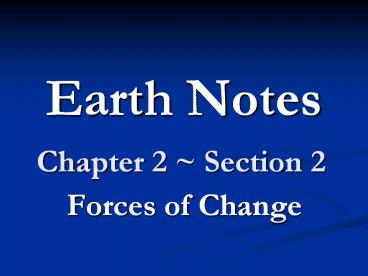Earth Notes - PowerPoint PPT Presentation
1 / 41
Title: Earth Notes
1
Earth Notes
Chapter 2 Section 2
- Forces of Change
2
The Earths Interior
- Inner Core about 4,000 miles below the surface
of the Earth - Outer Core 1,400 miles thick, temperature
reaches 8500F
3
Earths Interior (cont)
- Mantle layer of hot, dense rock MAGMA
4
Earths Interior (cont)
- Crust rocky shell forming Earths surface.
- The crust is broken into slabs of rock called
plates. - Natural forces interact with the crust, creating
landforms on the surface of the earth. - Below the oceans, the crust is about 5 miles
thick. Below the continents it averages 22 miles
in thickness.
5
Earths Interior (cont)
- Plates - float on a melted layer in the upper
mantle - - carry the earths oceans and continents
6
Internal Forces of Change
7
The Plate Tectonic Theory
- The lithosphere the earths crust and upper
layer of the mantle is broken into a number of
large, moving plates.
8
The Plate Tectonic Theory
- The plates slide very slowly over a hot, pliable
layer of mantle. - The earths oceans and continents ride atop of
the plates. - Its along the plate boundaries that most
earthquakes and volcanoes occur due to friction
and pressure that produces heat.
9
Plate Movement
- Plate movement creates oceans and mountain ranges
10
(No Transcript)
11
Plate Movement
- Continental Drift the theory that the continents
were once joined and then slowly drifted apart
12
Plate Movement
- Pangaea gigantic super continent which
eventually broke apart
13
(No Transcript)
14
Ring of Fire
- A circle of volcanic mountains surrounding the
Pacific Ocean - It is one of the most earthquake-prone
volcano-prone areas on the planet. - Hot Spots are hot regions deep within the mantle
that produce magma, which rises to the surface.
Volcanic island chains form as oceanic plates
drift over the hot spot. - Example Hawaiian Islands.
15
(No Transcript)
16
Volcanoes
- Form when magma inside the earth breaks through
the crust. Lava flows and may produce a large,
cone-shaped mountain - They often form along plate boundaries
- Magma splits the earths surface when plates
collide
17
(No Transcript)
18
- Faulta break in the earths crust. Movement
along a fault can send out shock waves, causing
an earthquake.
19
San Andreas Fault
20
San Andreas Fault
21
- A devastating fire followed the 1906 earthquake
in San Francisco
22
The San Fernando earthquake of 1971 collapsed
freeway overpasses in southern California
23
Converging/Collision Zone
- Plates collide and push slowly against each other
and form a collision or converging zone. - If 2 oceanic plates collide, 1 slides under the
other. Islands often form this way. - If 2 continental plates collide, mountains are
formed. Example Himalayas
24
Continental Crush / Collide
25
Spreading Zone
- Plates pull away from each other and form a
spreading zone. - These areas are likely to have earthquakes,
volcanoes, and rift valleys (a large split
along the crest of a mountain).
26
Spreading Zone
27
Subduction
- They meet, or CONVERGE and form a subduction
zone. - If an oceanic plate collides with a continental
plate, the heavier oceanic plate will slide under
the lighter, continental plate. - This results in volcanic mountain building and
earthquakes.
28
Subduction
29
External Forces of Change
30
External Forces
- What other forces can create landforms?
- Weathering a process that breaks down rock at
or near the surface into smaller pieces. This is
a VERY slow process thousands to millions of
years.
31
- Mechanical Weathering occurs when rock freezes
it can cause Frost Wedging, a crack in the rock
caused by freezing. - Chemical Weathering alters the rocks chemical
makeup by changing the minerals. This can
actually change one kind of rock into another.
32
- Important forces in Chemical Weathering are
moisture and carbon dioxide. - Through this process caves are created.
- Acid Rain causes another type of chemical
weathering that destroys forests, pollutes water
and kills wildlife.
33
EROSION
- Erosion is the movement of weathered materials
including gravel, soil and sand. - The most common agents of erosion are water, wind
and glaciers.
34
Erosion
- Erosion due to wave pounding at Venus Bay, South
Australia.
35
WATER AND EROSION
- Moving Water (rain, rivers, streams and oceans)
is the greatest agent of erosion. - Sediment small particles of soil, sand, and
gravel - are carried by the moving water and
works like sandpaper to grind away rocks.
36
Sediment
- Sediment from the River Rhône flowing into Lake
Geneva.
37
Sediment
- http//www.classzone.com/books/earth_science/terc/
content/visualizations/es0604/es0604page01.cfm?cha
pter_novisualization
38
Sediment creates new landforms such as
floodplains deltas.
- Deltas form at the mouth of a river
- Floodplains
39
Wind Erosion
- The second major cause of erosion is wind,
especially where there is little water and few
plants. - Wind Erosion can devastate one area while
benefiting another HOW? - Loess windblown deposits of mineral-rich dust
40
GLACIERS CAUSE EROSION?
- Glaciers are slow moving sheets of ice that are
formed over many years.
41
GLACIERS
- How do they cause erosion?
- The movement cuts though land creating lakes.
- They melt away and then rebuild again over
thousand of years.

